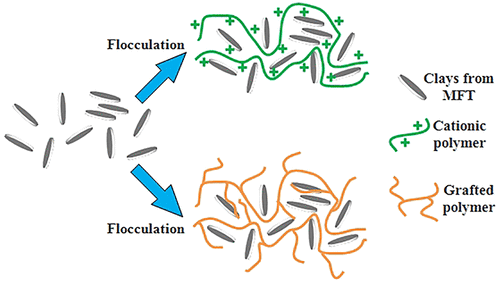当前位置:
X-MOL 学术
›
Energy Fuels
›
论文详情
Our official English website, www.x-mol.net, welcomes your feedback! (Note: you will need to create a separate account there.)
Dewatering of Oil Sands Tailings with Novel Chitosan-Based Flocculants
Energy & Fuels ( IF 5.3 ) Pub Date : 2018-03-12 00:00:00 , DOI: 10.1021/acs.energyfuels.7b03634 Leonardo Pennetta de Oliveira 1 , Sarang P. Gumfekar 1 , Fernanda Lopes Motta 1 , João B. P. Soares 1
Energy & Fuels ( IF 5.3 ) Pub Date : 2018-03-12 00:00:00 , DOI: 10.1021/acs.energyfuels.7b03634 Leonardo Pennetta de Oliveira 1 , Sarang P. Gumfekar 1 , Fernanda Lopes Motta 1 , João B. P. Soares 1
Affiliation

|
Mature fine tailings need to be dewatered to reduce the environmental impact caused by oil sands extraction. Polymer flocculants are commonly used to accelerate this process. In this work, we modified chitosan, a naturally occurring biopolymer, with 3-chloro-2-hydroxypropyltrimethylammonium chloride (Chito-CTA) and also grafted polyacrylamide to chitosan (Chito-g-PAM). We compared the dewatering performance of these two flocculants with that of a commercial cationic polyacrylamide (C-PAM). Chito-CTA and Chito-g-PAM dewatered tailings at rates of 18.27 and 20.72 m/h, respectively. The dewatering ability of Chito-CTA and Chito-g-PAM, measured in terms of capillary suction time (CST), was below 10 s, whereas the value for C-PAM was 82.3 s at optimum dosage. The turbidity of the supernatant obtained after flocculation with Chito-CTA or Chito-g-PAM was below 10 NTU, while C-PAM produced turbid supernatants. We studied the effect of flocculant microstructure on the specific resistance to filtration of the sediments. Chito-g-PAM produced sediments with the lowest resistance, 2.99 × 1012 m/kg, while C-PAM’s sediments had a much higher resistance of 40.26 × 1012 m/kg. We also used the focused beam reflectance measurement technique to determine floc size evolution, floc stability, and time required to induce floc formation. Our results indicate that chitosan-based polymers may be successfully used to treat oil sands mature fine tailings.
中文翻译:

基于壳聚糖的新型絮凝剂对油砂尾矿的脱水
成熟的细尾矿需要进行脱水,以减少油砂开采对环境的影响。聚合物絮凝剂通常用于加速该过程。在这项工作中,我们用3-氯-2-羟丙基三甲基氯化铵(Chito-CTA)修饰了天然存在的生物聚合物壳聚糖,并将聚丙烯酰胺接枝到壳聚糖上(Chito- g -PAM )。我们将这两种絮凝剂与商业阳离子聚丙烯酰胺(C-PAM)的脱水性能进行了比较。甲壳-CTA和Chito-克-PAM脱水尾矿以分别18.27和20.72米/小时,费率。甲壳-CTA的脱水能力和Chito-克-PAM以毛细管抽吸时间(CST)表示,低于10 s,而在最佳剂量下C-PAM的值为82.3 s。与甲壳-CTA或Chito-絮凝后获得的上清液的浊度克-PAM低于10 NTU,而C-PAM产生浑浊的上清液。我们研究了絮凝剂微观结构对沉积物过滤抗性的影响。Chito-克-PAM产生沉积物具有最低电阻,2.99×10 12米/公斤,而C-PAM的沉积物具有40.26×10高得多的电阻12米/千克 我们还使用聚焦光束反射率测量技术来确定絮凝物的尺寸演变,絮凝物的稳定性以及诱导絮凝物形成所需的时间。我们的结果表明,基于壳聚糖的聚合物可以成功地用于处理油砂成熟的细尾矿。
更新日期:2018-03-12
中文翻译:

基于壳聚糖的新型絮凝剂对油砂尾矿的脱水
成熟的细尾矿需要进行脱水,以减少油砂开采对环境的影响。聚合物絮凝剂通常用于加速该过程。在这项工作中,我们用3-氯-2-羟丙基三甲基氯化铵(Chito-CTA)修饰了天然存在的生物聚合物壳聚糖,并将聚丙烯酰胺接枝到壳聚糖上(Chito- g -PAM )。我们将这两种絮凝剂与商业阳离子聚丙烯酰胺(C-PAM)的脱水性能进行了比较。甲壳-CTA和Chito-克-PAM脱水尾矿以分别18.27和20.72米/小时,费率。甲壳-CTA的脱水能力和Chito-克-PAM以毛细管抽吸时间(CST)表示,低于10 s,而在最佳剂量下C-PAM的值为82.3 s。与甲壳-CTA或Chito-絮凝后获得的上清液的浊度克-PAM低于10 NTU,而C-PAM产生浑浊的上清液。我们研究了絮凝剂微观结构对沉积物过滤抗性的影响。Chito-克-PAM产生沉积物具有最低电阻,2.99×10 12米/公斤,而C-PAM的沉积物具有40.26×10高得多的电阻12米/千克 我们还使用聚焦光束反射率测量技术来确定絮凝物的尺寸演变,絮凝物的稳定性以及诱导絮凝物形成所需的时间。我们的结果表明,基于壳聚糖的聚合物可以成功地用于处理油砂成熟的细尾矿。



























 京公网安备 11010802027423号
京公网安备 11010802027423号